Data Privacy Protects Business Assets and Customer Interests
The interconnectedness of cybersecurity initiatives and the need to develop trusted relationships were recurring themes throughout the conference. Nearly every speaker acknowledged how challenging it can be to establish trust in the face of overwhelming rates of data generation.
According to Dominique Shelton Leipzig, privacy and security partner at the law firm Mayer Brown, “We are generating globally 2.5 quintillion bytes of data per day. That’s 18 zeros behind it.” Organizations face the dual challenge of unlocking the value of the data they’re creating while protecting the privacy of the people behind that data. If they neglect the former, they sacrifice potential profit and miss out on a competitive advantage. If they ignore the latter, they could lose the trust of their customer base, which is becoming increasingly informed about data rights and concerns.
“The issue of privacy has — almost, it seems, overnight — gone from a legal issue to a business issue. It seems like almost every day I pick up the news, and on the front page, there is something there dealing with data, privacy and insight,” Leipzig said.
Keith Enright, chief privacy officer at Google, said, “Processing data, even at that astonishing scale, can be good. If we are making people’s lives better, if we are delivering value to our users and our customers around the world and we’re doing it responsibly, we need to challenge this assumption that processing data is intrinsically negative or hostile or harmful. Because I don’t believe that’s the case if we're doing it in a responsible and thoughtful manner.”
READ MORE: Learn how to improve the customer experience without sacrificing data privacy.
Diversity Is the Solution to the Talent Shortage
A strong data privacy strategy demands innovation and expertise, both of which can be in short supply considering a widely acknowledged talent shortage. Recruitment and retention have become critical to any company looking to build a solid IT team and a culture of security.
“We need to really think about how we attract more talent and retain that. And that means we need to be more inclusive. We need to create platforms that every person, no matter who you are, can do your best work and thrive,” said Vasu Jakkal, vice president of security, compliance and identity at Microsoft.
“For 20 years now, we’ve dealt with the same problem. Our demand for security analysts, engineers, researchers and consultants far exceeds our supply. And every single day, that gap continues to grow,” said Bryan Palma, CEO of Trellix.
“Our lack of diversity is holding us back in two important ways. First, we are turning away great people and doing our industry a significant disservice. By failing to cultivate a more inclusive environment and neglecting to provide pathways for more female and non-binary people, people of color, and people from the LGBTQ+ community, we are only widening our already enormous talent gap. We are all better when we benefit from the diverse perspectives of others,” Palma said.
Palma said a less diverse IT team is simply bad for business. “Our lack of diversity restricts our ingenuity, innovation and ability to recruit the next generation of talent.”













